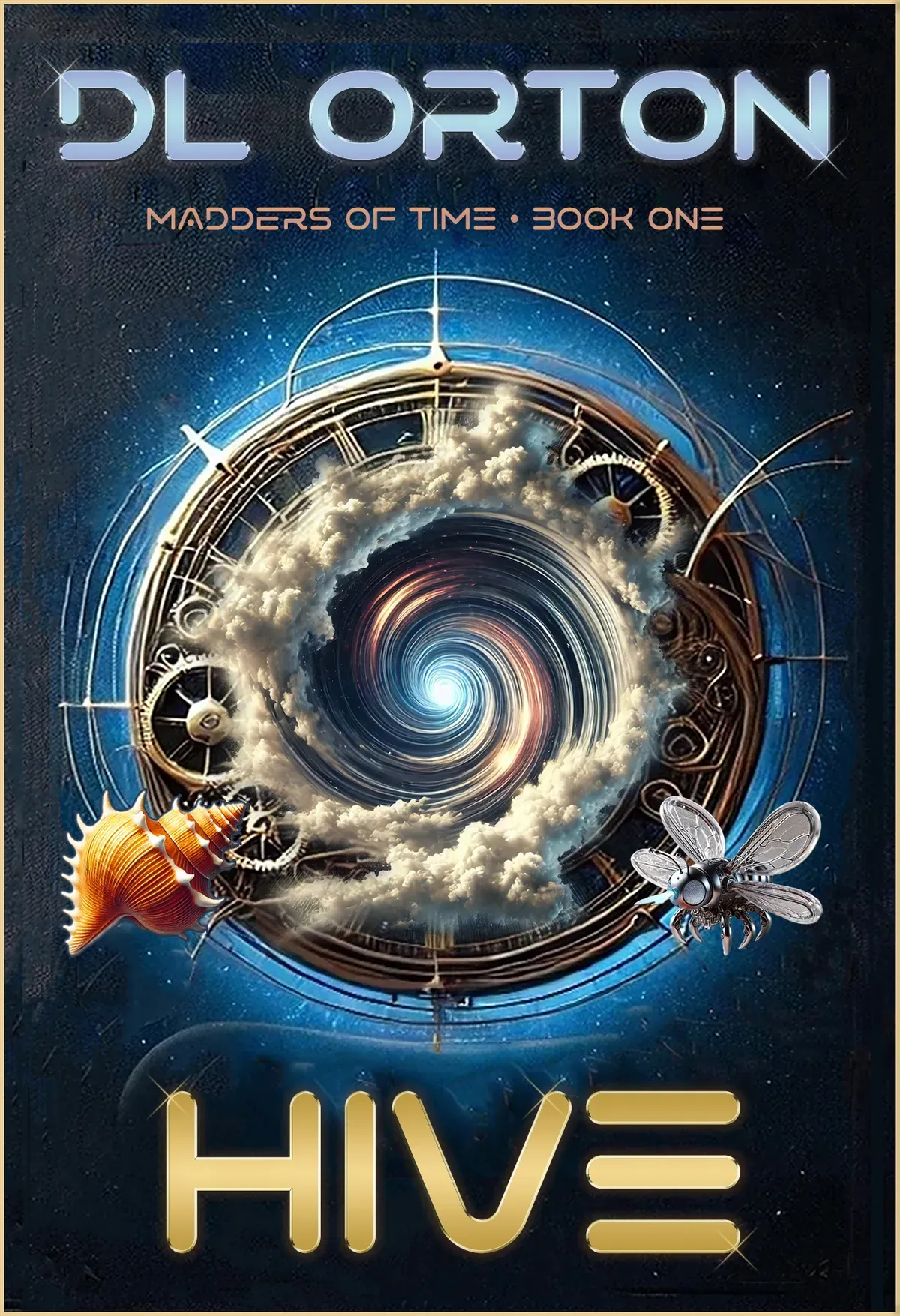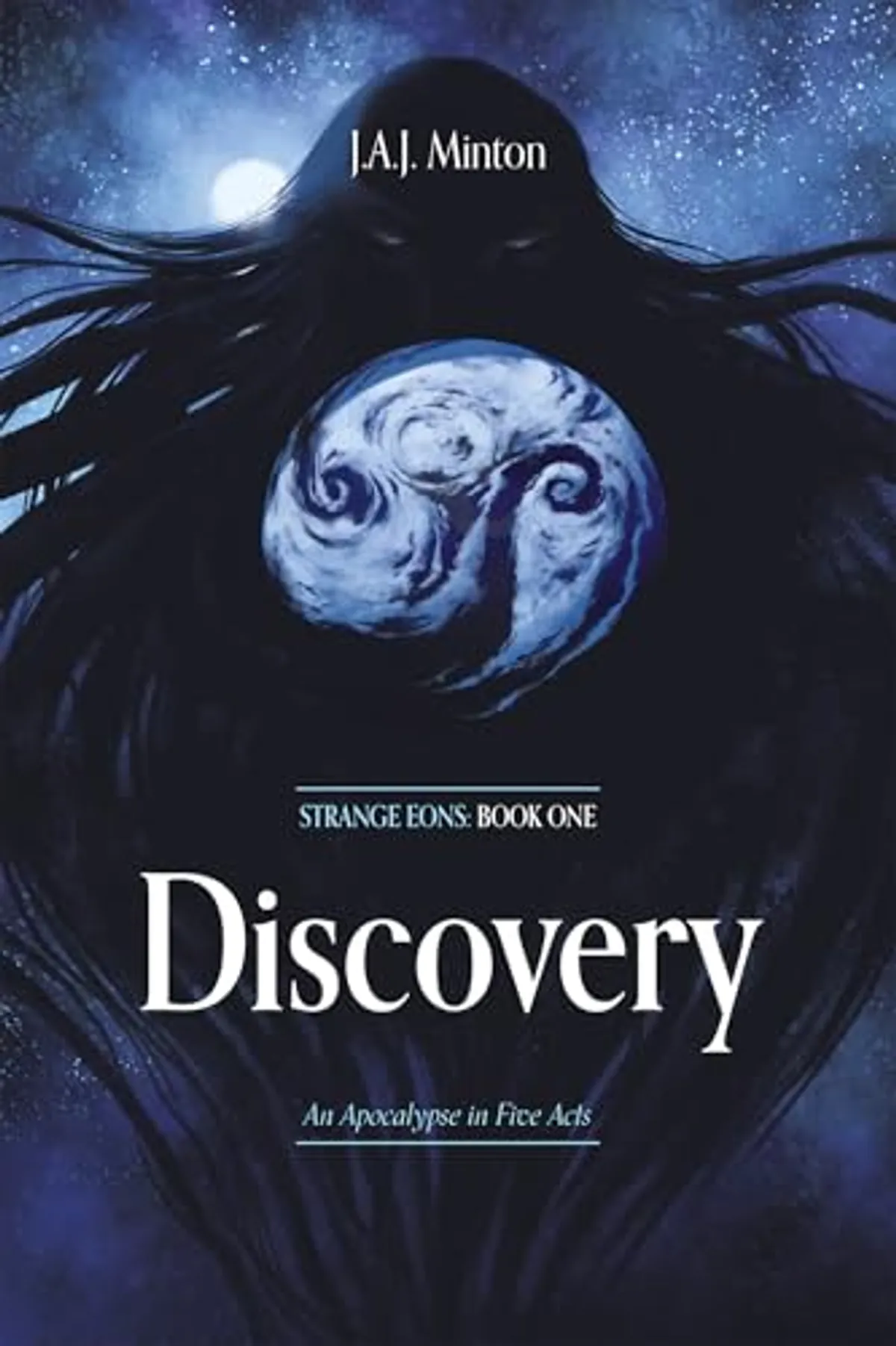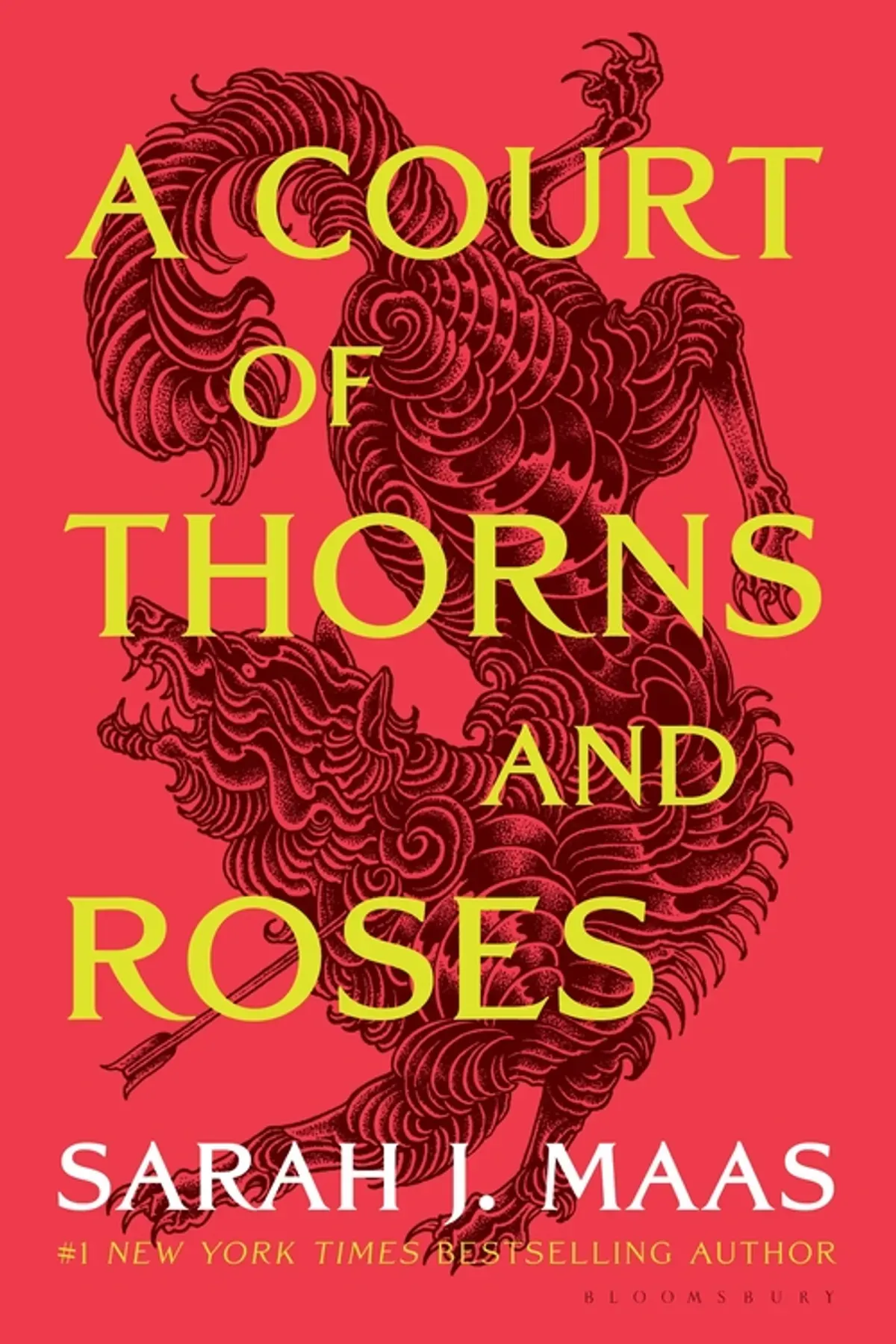Hive
by D.L. Orton
Reviewed by Devin Ford on April 10, 2025
Est. Reading Time: 8 min
ARC Disclosure: This book was received free of charge from Rocky Mountain Press in exchange for an honest review.
At a Glance: Time Travel Twists in a Dying World
The final remnants of humanity survive within the Eden-17 biodome in a dying world swarming with microdrones. Isabelle Sanborn sees the deadline drawing near but a daring scheme remains which could afford humanity another opportunity. Isabelle uses Madders, the mysterious AI created from a physicist’s memories, to send Diego Nadales thirty-five years back in time. His mission? Diego’s goal is to redirect historical events to save their collapsing world.
Upon reaching the vibrant but delicate Main Timeline Diego encounters remnants of his history that include a young Isabelle. Diego fights to create a better future while carefully managing relationships and events to avoid unraveling time itself.
A Decaying World With Familiar Echoes
The worldbuilding in Hive functions through two separate levels. The future timeline shows a grim and dystopian world where human survival hangs in balance within a collapsing biodome as deadly microdrones swarm the weakened structure. The grim setting powerfully defines the urgent objectives behind the main time travel storyline.
The current timeline appears intentionally conventional yet borders on being overly recognizable. I struggled to stay immersed in the narrative because the real-world environment with familiar places and modern technology stood out too much. My preference for high fantasy and distant science fiction created a distracting effect when the narrative remained grounded in the contemporary world.
The narrative succeeds with the tension created by dramatic irony which allows us to witness Diego’s efforts to save his world while simultaneously seeing the future apocalypse he fights to stop. The dual-timeline storytelling method heightens suspense by illustrating the extensive consequences of Diego’s potential failure in his mission.
The time travel science and microdrone crisis establish believable support for the story without delving into technical details. To preserve immersion I would have liked the story to take place in a setting further removed from our reality or to present a more unique version of our world.
Characters Across Time
Hive’s characters illustrate their complicated situations while their growth occasionally becomes secondary to plot mechanics. Through Diego’s journey we experience the bewildering nature of time travel while he bears the heavy responsibility of a doomed future. He displays remarkable determination but seems to be defined more by his mission than by unique personality features.
The narrative showcases Isabelle in various forms throughout different timelines which provides a fascinating dynamic through her dual existence in both the future and present. The differences between her present and future selves emphasize how identity evolves through life circumstances although I sometimes wished to learn more about her personal thoughts beyond the crises she encounters.
The secondary characters contribute meaningful layers to the narrative. Matthew Hudson delivers both humorous moments and human touches that help balance the darker aspects of the story. The way he connects with other characters creates some of the narrative’s most engaging and relatable scenes.
Character relationships generate real emotional stakes that amplify the overall apocalyptic danger. The timeline-spanning connections between Diego and Isabelle make their interactions complex while keeping romantic elements subdued throughout their story.
A Plot That Builds Momentum
The narrative of Hive begins with a gradual and somewhat confusing pace before developing into an engaging drive. Early chapters demand patience while the narrative develops its core elements and reveals how time travel functions. The narrative thrusts readers into the story without much explanation creating mystery yet risk confusion.
The narrative gains momentum when the multiple storylines start to merge as the book advances. Curiosity stems from the question of how current events link to a future apocalypse while Diego experiences heightened urgency due to his time-sensitive mission. The storyline maintains equilibrium between individual risks and worldwide impacts which renders both personal scenes and global events significant.
The narrative alternates between intense episodes and slower sections focused on character development and world-building. The narrative had me fully engaged by the midpoint because the interwoven timelines were becoming clear and character motivations developed into deeper complexities.
The ending wrapped up main plot points fully yet left some questions open which allows the narrative to expand in future books while still delivering a fulfilling conclusion. The story reaches sufficient progress so readers feel rewarded instead of frustrated despite some loose ends.
Between the Sheets: Restrained Romance
BroMantasy Spice Rating
Barely There
(Chaste Romance)
The romantic elements in Hive are kept subtle which results in a spice level of 🌶️ (1.0). Romantic elements concentrate mainly on building emotional bonds instead of providing physical details. Diego and Isabelle’s relationship serves as the emotional core of the story while preserving the science fiction themes.
The author builds romantic tension with meaningful glances and understated moments instead of explicit scenes. The method maintains attention on the expansive storyline while recognizing personal relationships as key forces behind character actions.
Hive delivers an ideal blend for science fiction enthusiasts who appreciate romantic elements in their stories. The narrative tension rises through character dynamics which increase emotional stakes without dominating the story.
Bro Reading Comfort: Generally Approachable
The book Hive contains a minimal amount of questionable public reading content with a rating of 😳(1.0) which makes it suitable for public reading without causing major concerns. The narrative of the book centers mostly on science fiction elements and character growth while avoiding sensitive content that could cause public reading concerns.
The rare intense moments fit well within the story and remain short enough to avoid making most readers feel uncomfortable. The scientific terminology and time-travel concepts in the book draw more questions from inquisitive readers than its main narrative.
The cover design of the book remains tasteful and suitable for its genre while steering clear of any images that may deter public reading. Hive presents no reading concerns for most public environments.
Darkness With Purpose
The apocalyptic future timeline of Hive joined with life-altering choices gives it a darkness rating of (3.0) 💀💀💀 as it explores humanity’s chance of survival. The book presents the harsh realities of a dying world without hesitation which includes powerful moments of loss and desperation.
The darkness exists to enhance the story instead of being included simply to startle readers. Diego’s mission gains urgency from the bleak future timeline but finds relief through the contrasting present-day timeline which offers hope. The narrative balance stops the dark elements from becoming too dominant.
The strongest moments arise from the emotional burden of making impossible decisions and the weight of potentially changing history. The narrative gains depth from its moral and philosophical elements which enhance the darkness instead of using only external threats.
The story maintains hope as an opposing force to despair throughout its development. Both characters and readers find motivation to progress through the story’s darker sections because they have the chance to rewrite history and eliminate tragic events.
Book Battlefield: Finding Its Place
Hive holds a unique place within the genre of time-travel science fiction. The book investigates time-bound relationships similarly to Audrey Niffenegger’s “The Time Traveler’s Wife” yet includes stronger science fiction elements. The story’s end-of-the-world themes remind readers of Emily St. John Mandel’s “Station Eleven,” although these are triggered by technology instead of a pandemic.
Character-focused time travel enthusiasts will find Hive an accessible starting point through its balanced combination of scientific elements and human drama. The dual-timeline structure generates simultaneous short-term and long-term stakes that set it apart from other time travel stories with a narrower focus.
The book Hive faces challenges when trying to create a distinctive voice within the saturated field of its genre. Although the contemporary setting resonates with readers it fails to deliver the unique worldbuilding elements needed to distinguish it from other similar stories. Through its examination of the ethical implications of time modification the book achieves remarkable philosophical complexity.
The book succeeds most effectively because it remains easily accessible to readers. New science fiction readers will encounter recognizable elements that serve as a foundation and genre fans will value the book’s meticulously crafted time travel systems and their outcomes.
Should You Bother?
For Time Travel Enthusiasts: Hive presents a compelling look at the possibility of altering past events to protect the future through complex timelines and thorough examination of cause and effect relationships.
For Character-Driven Sci-Fi Readers: The character relationships spread across various timelines create emotional resonance which surpasses the scientific themes in the story.
For Dystopian Fiction Fans: The narrative builds compelling tension through its depiction of stark differences between present-day settings and apocalyptic future scenarios.
For Casual Science Fiction Readers: The book delivers complex concepts in a way that appeals to readers who usually avoid hard science fiction novels.
Final BroMantasy Verdict
Hive by D.L. Orton delivers an interesting time-travel narrative that centers around strong emotional themes but might not appeal to readers who favor less personal speculative worlds. The core strengths of the book emerge from its dramatic main premise and the ethical challenges of changing historical events.
Though the storyline initially progresses slowly the plot eventually pulls in readers who wait for the timeline connections to become more apparent. Diego and Matthew serve as entry points for understanding the narrative’s complexity yet their character growth might seem to be secondary to plot mechanics for some readers..
Hive shows us that common environments can become fascinating when we perceive them as on the brink of disaster. The disparity between the end-of-the-world future and our current world creates narrative tension that propels the story.
Hive provides a science fiction adventure that combines complex technical concepts with human drama to create an engaging experience for readers who want meaningful emotional stakes. The book doesn’t redefine time travel storytelling but presents an insightful examination of human determination to preserve their most important things.
The initial book of the series, Hive builds its fictional universe and main conflict while leaving sufficient mysteries to compel readers to continue with the series. Even though the book did not match my preference for settings with less modern elements it still offered an intriguing plot that kept me engaged until the end.
You Might Also Enjoy
Frequently Asked Questions
Is this book part of a series?
Yes, this is book 1 in the Madders of Time series.
How spicy is the romance?
We rate the spice level at 🌶️ (1/5). Minimal romantic elements that support character relationships without explicit content
How uncomfortable is it to read in public?
We rate the public reading discomfort level at 😳 (1/5). Few concerns for public reading beyond occasional intense scenes
How dark are the themes in this book?
We rate the darkness level at 💀💀💀 (3/5). A bleak future timeline with powerful moments of loss and desperation as humanity faces extinction
What age group is this book for?
This book is generally recommended for adult readers due to its mature themes. We recommend checking specific content warnings if you are sensitive to certain topics.





